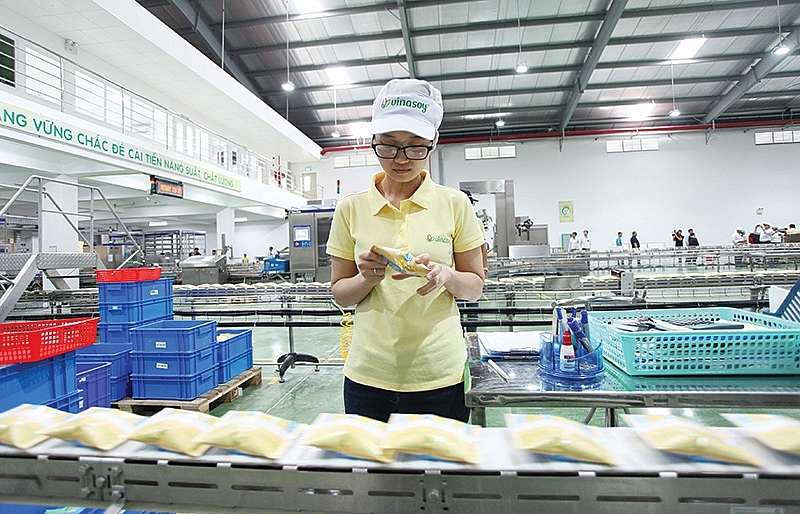CPTPP a guarantee of new investment wave
a-
 |
Over recent years, Vietnam has inked and engaged in 12 free trade agreements (FTAs), with the recent adoption of the Comprehensive and Progressive Agreement for Trans-Pacific Partnership (CPTPP).
The CPTPP is a very special agreement that has attracted major attention from the public because it is the new version of the original Trans-Pacific Partnership (TPP), considered a “golden standard” of the 21st century but which was on the verge of falling apart after the United States decided not to partake in it.
Thus the signing and adoption of the CPTPP has demonstrated the strong commitment and efforts of the deal’s 11 member states in general and of Vietnam in particular.
The implementation of the CPTPP will have great impact on some of the key aspects of the deal.
Specifically, it will help Vietnam boost institutional reform. The acceleration of this reform for Vietnam to build a modern socialist-oriented, market-based economy and integrate further into the global economy requires great efforts from the government. However, it will bring huge benefits to businesses and people when the deal is implemented.
The CPTPP is considered a role-model trade pact of the 21st century and a new-generation FTA, because it not only covers extensive commitments on tariff reduction and removal, but also consists of a large number of commitments relevant to many aspects of the economy, such as state-owned enterprises, subsidy, competition, intellectual property rights, labour, trade union, and the environment.
In the context that we have already seen many FTAs, with import tariffs trending to be reduced to zero, it is the non-tariff factors that are key barriers in international trade and require the most attention.
With a scope of comprehensive commitments including tariff and non-tariff issues, the CPTPP will create strong pressure and impetus for Vietnam, which has the lowest economic development level among other member states, to make greater efforts to partake in this level playing field in a fair manner.
According to the World Bank, the CPTPP membership will help Vietnam increase its GDP by another 1.1 per cent, and export turnover by another 6.9 per cent by 2030.
Whether this will happen or not, and whether Vietnam can benefit from the FTAs, would largely depend on domestic institutional reform, whose pivot is the improvement in the law system, policy transparency, the business climate, and the economy’s competitiveness.
 |
| The CPTPP era will bring vast benefits, but Vietnamese businesses must ensure they improve product quality |
The CPTPP will also help Vietnam expand its export markets, balance trade, and attract more foreign investment. Under the CPTPP commitments, member states commit to completely remove 97-100 per cent of import tariff lines for goods sourced from Vietnam. This means that nearly all Vietnamese goods exported to other CPTPP nations will be able to enjoy zero import tax right after the deal comes into force, or under specific roadmaps. Thus, with its biggest commitments to open the domestic market among the FTAs that Vietnam has inked over the past few years, the CPTPP will open wide doors for Vietnam’s goods to further enter other CPTPP member states, especially Canada, Peru, and Mexico.
If these markets are exploited well, Vietnam will not only be able to increase exports but will also be able to reduce the over-reliance on a specific export market region.
Currently, Vietnamese exports are still concentrated in a number of major and traditional markets, such as the US, the EU, China, Japan, and South Korea. In the event that these markets have some changes, for example due to the existing US-China trade dispute, it is certain that Vietnam’s export-import activities will be more or less influenced.
Thus, in addition to maintaining and strengthening these traditional markets, it is quite necessary for Vietnam to expand to other new markets through the CPTPP, because this will help the country’s exports develop in a more stable and sustainable manner.
Not only that, opportunities for made-in-Vietnam goods thanks to the CPTPP will also increase the attractiveness of the country’s investment and business climate to foreign investors. In fact, even as the TPP was about to be inked, many foreign-invested projects came to Vietnam in anticipation of opportunities induced by the deal, in terms of tariff incentives and rule of origin.
More importantly, Vietnam’s participation in the CPTPP with extensive and comprehensive commitments has manifested the strong commitment of the Vietnamese government in trade liberalisation and improvement of the business climate. In other words, Vietnam’s participation in the CPTPP is a guarantee for foreign investors to pin their hopes in investing in the country.
However, the CPTPP will also increase pressure for Vietnam. When talking about tariff reduction and removal, and opening the service market and public procurement, we also need to know that goods and services from CPTPP member states will also enter Vietnam.
Without thorough preparations, there will probably be risks in narrowed production, loss in market share, and even bankruptcy. However, businesses should not be too worried, because before the CPTPP was signed, Vietnam already acquired FTAs with seven of the 10 CPTPP member states, not to mention other FTAs. The participation in these agreements over the past few years have helped Vietnamese enterprises gradually get used to the country’s commitment roadmaps within them.
Data about a rise in exports and imports, and investment over the past few years, showed that Vietnamese businesses have been able to weather the strong competition from FTAs, and they have even taken advantage of the incentives given by the FTAs.
Thus, Vietnam’s participation in the CPTPP is surely not a shock in terms of competition for domestic enterprises, especially when a number of CPTPP markets have an export-import structure that can complement the country.
Though there will be a rise in competitive pressure, we can completely weather this challenge thanks to our vast experience in implementing previous FTAs.
Nevertheless, Vietnam’s CPTPP membership will also mean a string of technical trade barriers which will be a major challenge for Vietnamese enterprises. In the CPTPP, Vietnam’s partners are nations with a high economic development level in the Asia-Pacific region. Despite the removal of tariff barriers, we will have to overcome other obstructions which are related to technical standards for export goods.
If we can overcome these hurdles, our goods can really enter the CPTPP markets. Besides, even when our goods are made available in these markets, we may also have to make preparations for possible risks about trade remedies and anti-dumping tax imposition. Reality showed that over the past few years, Vietnam’s goods have faced many relevant cases involving these measures.
In a nutshell, when joining high-standard FTAs and new-generation ones like the CPTPP, we must double down on our efforts. The government must boost institutional reform, and improve the domestic business climate. Meanwhile, local businesses must improve the quality of their goods and services in order for them to both expand markets and keep their market share right here in Vietnam.
The country’s participation in the CPTPP will make the FTA playing field more bustling and attractive. However, local businesses are advised to have a better understanding about commitments and rules so that they can perform more professionally.
The CPTPP is clearly providing fuel for Vietnam’s international economic integration. However, there is a big need for concerted efforts and actions from government agencies, to the business communtiy and local people, so that this fuel can be converted into energy for the entire economy.
What the stars mean:
★ Poor ★ ★ Promising ★★★ Good ★★★★ Very good ★★★★★ Exceptional
Themes: CPTPP
Related Contents
Latest News
More News
- Kolon signs $48 million airbag supply deal with Autoliv (December 15, 2025 | 18:14)
- National Assembly approves Vinh–Thanh Thuy expressway project (December 15, 2025 | 18:02)
- Quang Tri green-lights $1.59 billion LNG-fired power project (December 15, 2025 | 17:59)
- Stress laid on high-quality FDI inflows (December 15, 2025 | 11:00)
- Can Tho utilises its growth advantages (December 15, 2025 | 09:09)
- Ca Mau unlocking potential to shape a more sustainable future (December 15, 2025 | 09:02)
- Major projects to be inaugurated nationwide (December 15, 2025 | 08:00)
- MoF workshop highlights mounting concerns over ODA on-lending costs (December 12, 2025 | 16:05)
- National Assembly approves pilot mechanisms to accelerate major projects in Hanoi (December 12, 2025 | 11:29)
- Legislation gives government flexibility for loan guarantees (December 11, 2025 | 18:04)

 Tag:
Tag:






















 Mobile Version
Mobile Version